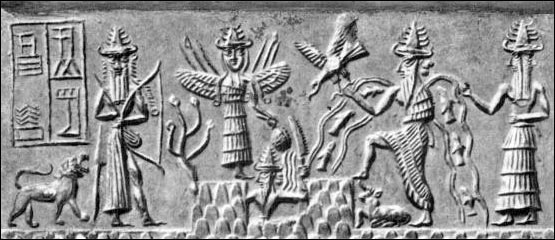Date
Second half of the third millennium B.C. [--Parrot.]
Origin
The Ancient World : The Middle East : Sargonid Period
Description
Left, inscription, small figure of roaring lion; bearded god (Ninurta
?), wearing long skirt exposing one leg, four-horned crown, carrying
bow; center, bearded god wearing four-horned crown, flames rising from
shoulder, holding saw-knife, rising from cleft in mountain; on top of
mountain at left, four-branched plant, winged goddess wearing long flounced
garment, four-horned crown, three straight lines (vegetation ?) rising
from shoulders, holding straight stick-like object terminating in sphere
at one end; right side of mountain, bearded god (Ea ?) wearing four-horned
crown, long flounced garment, stream of water containing fish flowing
from each shoulder, holding bird in upraised hand, striding to top of
mountain over recumbent bull; far right, bearded Janus-faced figure
wearing long flounced skirt, four-horned crown, gesturing with raised
right hand.
Levy comments that the god being liberated from his mountain grave is
not Tammuz since he wears the sun's rays on his shoulders and carries
the saw by which the mountain is cleft. The sun-god assimilated Tammuz,
and the older ritual for assisting the crises of seasonal change was
enlarged in scope to comprise a similar cycle in the causal world. As
in Egypt the sun-god's boat passes nightly underground. In this connection
she recalls the texts which describe the kishkanu tree of the underworld,
with fruit of lapis lazuli, which shades both Shamash and Tammuz, that
is the Sun in his night or winter sleep, with whom the dying fertility
god was made one.
Frankfort discusses both the mythological and ritual connotations of
the iconography. The public rites of the New Year's festival effected
the resuscitation of the god by bringing him assistance. As the sister
descended to Lillu, as Ishtar descended to Tammuz, so the people descended
in ritual, by wailings and laments, to the imprisoned god. This ritual
descent effected a reversal of mood and the god was brought forth triumphantly
to the world of the living.
Frankfort suggests that the ancient rites must have had traditional
settings. Possibly the ziggurat, the massive temple tower, which stood
for the "mountain" as a symbol of the earth, the Netherworld,
or the place of sunrise, counted as the temporary tomb of the god. The
public rites in Babylon in later times included seeking after the imprisoned
god, the arrival of barges with statues of the gods from Nippur, Uruk,
Cutha and Kish, the triumphal entry of Nabu ("he who comes to seek
after the welfare of his father who is held captive") and his battle
with the enemies of Marduk, and the victorious procession of the resurrected
god.
Frankfort writes "The thought that death is vanquished at the beginning
of the New Year survives in the religions which originated in the Near
East, because it carries conviction through the harmony which it establishes
between the visible and invisible worlds." He notes that Christian,
Jewish and Moslem texts connect the resurrection of the dead with the
life-giving rains. "It is clear therefore, that the complexities
of the New Year's festival in Babylonia are due not to syncretism, but
to a chain of connections which were suggested to early man by the natural
conditions under which he lived and which consequently retained their
validity for his descendants. The seasons of spring and autumn bring
rain and the victory over death. The god is liberated from the mountain."
Frankfort notes that the cylinder seals of the middle of the third millennium
show the liberation of the god from a mountain by the liberator, a god
with a bow (Ninurta), with a goddess in attendance. Sometimes the goddess
is shown kneeling with the captive god inside while another god destroys
the vegetation above ground. The myth rather than the rite is depicted,
reflecting the ancient source of the ritual if not the form it took.
Kramer comments that the scene attempts to portray a mythological story
and identifies three of the gods. At far right is Janus-faced Isimud,
messenger of Enki. Second from right is Enki, the water-god, and center,
rising from the lower regions is Utu, the sun-god. He conjectures the
possibility that the scene might illustrate the tale of Gilgamesh, Enkidu
and the Netherworld although Enkidu is not represented and Isimud plays
no part in the story. The figure at far left might be Gilgamesh and
the goddess Inanna might be standing beside the huluppu-tree from which
she made the pukku (drum ?) and mikku (drumstick ?) for Gilgamesh.
Object
Seal (cylinder; impression).
Style or School
Akkadian.
Material or Technique
Glyptic.
Repository or Site
London: Mus., British.
Image Sources
from Parrot.* [JF 1295]
References
*Parrot, A., Sumer (1961), pl.237.
Levy, G. R., Gate (1948), p.171; pl.23b.
Frankfort, H., Kingship (1948), pp.321-25; fig.50.
Kramer, S. N., Sumerian (1961), pp.32,33-7; pl.7.
|

